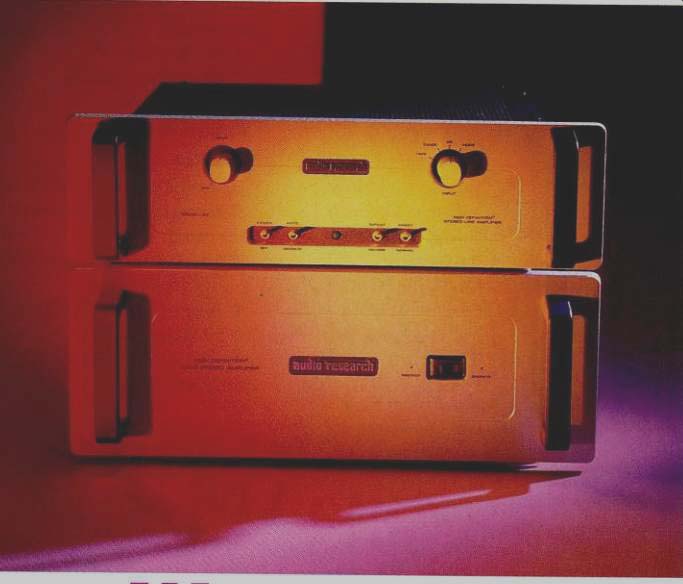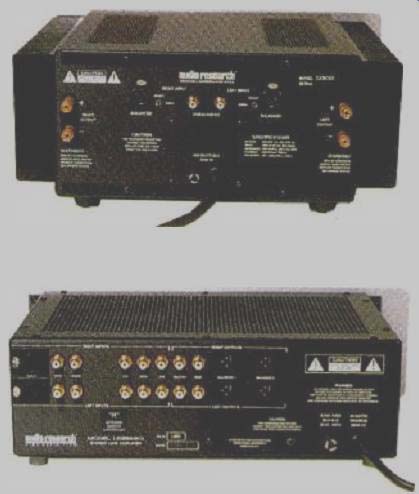
Company Address: 5740 Green Circle Dr., Minnetonka, Minn. 55343; 612/939-0600.
When you think about it, there is a surprisingly long list of high-end firms whose product excellence we all take for granted. You know, even before you open the box, that quality will be high in terms of design features, construction, and sound. You know the manufacturer's track record, and if you are considering a line-stage preamp and/or amplifier, you can be almost certain the sound will be at least very good and that the measured frequency response and distortion will be so good that you can't possibly relate them to perceived sound quality. Audio Re search is one of those manufacturers. I could begin virtually every review of Audio Research equipment with the comment "Another fine pre amplifier" or "Another fine amplifier."
Yet it takes a certain indifference to reality to claim that Audio Research products sound just the same as my Krell, Pass Laboratories, or Classe Audio reference preamps and amplifiers-or that they sound the same as the preamps and amps of other leading high-end manufacturers whose products are designed around a different perception of musicality. The differences in sound may be ones of nuance, but they are the kind of differences that make a high end system into a personal statement of how the owner defines the sound of music.
Furthermore, no one who has had any experience with the products of a well-established high-end manufacturer fails to hear changes over time-changes that are almost al ways for the better. Audio Research is again a good case in point. The company earned world-wide recognition by producing equipment that created a new interest in tube de signs at a time when the rest of the audio world was rushing-perhaps prematurely-into transistors.

Audio Research, however, has come a long way from the era when tube sound meant considerable warmth, a loss of tightness and control in the deep bass, and a tendency toward slightly rolled-off highs. In fact, the days when tubes were "warm" and solid-state devices were "dry" have been over for at least half a decade. Longtime firms such as Audio Research have shown that tube electronics can provide both the sweetness and exceptional dynamic life of top tube designs and the flat frequency response and bass power and control of the best transistor designs. Further, Audio Research has expanded to become a top solid-state manufacturer while remaining a top manufacturer of tube equipment. The Audio Research LS2B Mark II preamp and D300 power amplifier are both good examples of this process of evolution. The preamplifier sells for $2,650 in its basic configuration (the LS2 Mark II), $2,995 with balanced inputs (the LS2B Mark II), and $3,495 with both balanced inputs and a remote control. It is a hybrid tube and solid-state line-stage preamplifier that uses FET devices for its input and output circuitry and 6922 dual triodes as its main gain amplifier. The 6922, incidentally, is one of the many benefits of the end of the cold war. It is a Russian-made tube that Audio Research finds has exceptional reliability and long life.
Audio Research emphasizes during de sign implementation the systematic selection of the best-sounding components, as well as solid technical engineering, but the LS2B Mark II does have a number of especially interesting design features. The Mark II in the model name of the preamp indicates that amplified feedback is used to provide buffering and to avoid loading down the output. The unit provides 18 dB of gain and is a true Class-A circuit capable of swinging 50 V of output, peak to peak. FETs are used as constant-current devices to get improved linearity and power-supply regulation.
As is increasingly common with modern preamps, a great deal of engineering effort has gone into designing the power supply. Audio Research's engineers believe that in the past, power-supply limitations-not solid-state devices-were responsible for much of the dryness and lack of dynamics that used to be associated with "transistor sound." Two power transformers are used; the smaller transformer feeds and effectively isolates the active balanced input circuit. It uses advanced coaxial capacitors and de-coupled electrolytic-capacitor networks. A new generation of ICs is used for error control in the regulators, and even the low-voltage regulators use current-feedback de vices rather than op-amps.
The Audio Research LS2B Mark II is a minimalist preamp in terms of features. You have a choice of five high-level inputs, a "Gain" control, and "Power" and muting switches. The rest of the control layout clearly emphasizes sonic purity, at the cost of eliminating the balance control and tape-monitor switch. You do, however, get a front-panel tape-defeat control that by passes the tape output circuitry and pre vents any risk of interaction with a tape deck. A "Direct/Normal" input switch allows you to bypass the switching circuitry for the balanced "Direct" input on the back-adding another element of sonic purity. Further, the balanced input on the LS2B Mark II has a 3-megohm input impedance, which Audio Research feels reduces the loading on source equipment and both opens up the sound and provides better musical integrity.
The sound character of the LS2B Mark II is as you might expect from this design emphasis. Its sound is very clean, very de tailed, and very transparent. There is no particular warmth or character of timbre, and no coloration in the bass, midrange, or treble. The LS2B Mark II clearly emphasizes neutrality over any euphonic kind of coloration, a neutrality that will delight some tube fans but disappoint others.
Any former Audio Research SPI1 owner-and I am one-is going to find that the LS2B Mark II does an excellent job of preserving some of the best in tube sound. It has the exceptional dynamic life that I, at least, expect from the best tube preamps, and it combines outstanding dynamics with outstanding resolution. In contrast, even some of the best transistor gear tends to slightly soften dynamics and the natural energy of music, particularly at low levels or in complex passages.
Some preamps have more apparent depth, but few sound more open or do a better of job of imaging. The soundstage is very live and open, with excellent left-to-right spread and well-focused imaging. Further, imaging is not artificially fixed in place, or spotlighted, and it is very good from front to back as well as excellent from left to right. The soundstage was good enough to make me forget the absence of a balance control-at least, most of the time. I normally like to lock in the imaging and soundstage of a given record or CD with small adjustments to the balance control, but I only missed this capability with a few unbalanced recordings.
In short, the Audio Research LS2B Mark II gives you accuracy and not romance. This preamplifier will never dazzle you with features or woo you with some pleasing coloration. What it will do is provide an outstanding mixture of the best in tube and solid-state sound.
The D300 stereo amp is a bit more conventional, at least in the sense that it is all solid-state. It sells for $3,995 and provides 160 watts per channel into 8 ohms and 300 watts into 4 ohms. It can be bridged to provide 600 watts into 8 ohms and 900 watts into 4 ohms. The power bandwidth ranges from d.c. to 150 kHz into 8 ohms, and noise is rated at 116 dB below output. The damping factor is a relatively high 130, the slew rate is 50 µV/S, and the rise-time is 1.7 µV. The input impedance is 150 kilohms unbalanced and 300 kilohms balanced; the amp is noninverting.
There are no front-panel features other than an off/on switch and two lights that indicate whether the amplifier is in "Operate" or "Protect" mode. The rear panel has two RCA inputs, two balanced XLR inputs, two sets of stereo binding posts, the usual fuse-holder, and switches to select the balanced or unbalanced inputs.
The design philosophy and sound of the Audio Research D300 bear a striking resemblance to those of the LS2B Mark II preamp. The circuit and components were chosen on the basis of exhaustive listening tests, with the goal of providing as much as possible of the openness, clarity, and dynamic life that Audio Research feels are the great strengths of tubes.
Like the LS2B Mark II preamp, the D300 uses constant-current devices and a complex power supply with distributed electrolytics and premium components. A higher voltage, or rail, with a capacitance multiplier (or ripple stripper) is used in the lower gain stage in order to provide more open dynamics.
The D300 blends the use of J-FETs and bipolar transistors in what Audio Research believes is the best-sounding use of each device. There are no MOS-FETs in the active audio circuitry. The D300 uses direct coupled, high-current multiple-emitter transistors in the output stages, which Audio Research feels have the ruggedness of single-emitter bipolar devices and the sweetness of MOS-FETs. The D300 uses plastic output devices-not because they are cheaper than metal devices, but because Audio Research feels they sound bet ter. The subsonic limiting and protection circuitry are chosen to sound neutral.
As for sound character, the D300 is very similar to the LS2B Mark II. The D300 has a very fast, live, and dynamic attack and an open soundstage. It does not warm the sound, add extra bass power, or alter timbre, although it is clean enough so that it may appear to have more detailed highs and upper midrange energy simply because more of the signal gets through. This added upper octave transparency is a real blessing with today's best CD players and D/A converters but is unforgiving with hard or excessively close-miked recordings and poor CD players or converters.
The apparent S/N is also excellent. Like a lot of today's best high-end equipment, the music seems clean at lower signal levels, emerging with less of the vestigial electronic "haze" or noise you sense with older equipment, even equipment that has excel lent overall S/N.
The Audio Research D300 did an exceptional job of getting the best out of difficult speakers. It performed very well with a low-impedance ribbon speaker, a Quad electrostatic, the Spendor BC-1, and the Thiel CS5i. In fact, the D300 got some of the best performance out of the Thiel CS5i that I have yet heard from any amplifier.
By any standard, the Audio Research LS2B Mark II and D300 make an outstanding combination, one that offers much of the best in tube sound. You also have a wide range of potential choices in prices and power. I prefer balanced inputs, but choosing the LS2 Mark II over the LS2B Mark II offers substantial savings, and a re mote control is a luxury that contributes nothing to sound quality. Similarly, the D300 is part of a family of amplifiers that includes the D400 Mark II, with 200 watts per channel and a price of $5,495, and the D200 with 110 watts per channel and a price of $2,495. If you are on a budget, the cheaper combination may be a great deal more appealing.
Do remember, however, that audio is a sport that is based on careful comparative auditioning. There is no one right answer to reproducing the illusion of live music, and the nuances in top high-end electronics are considerably subtler than those in speakers. You'll miss half the fun in buying audio equipment if you don't listen to a range of products like the LS2B Mark II and the D300.
-Anthony H. Cordesman
[adapted from AUDIO magazine/Jan. 1995]
Also see:
Audio Research LS3 B Line Preamp (Auricle, Mar. 1993)